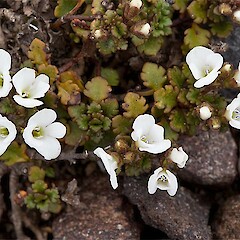Veronica spathulata
Common name
parahebe
Synonyms
Parahebe spathulata (Benth.) W.R.B.Oliv.
Family
Plantaginaceae
Flora category
Vascular – Native
Endemic taxon
Yes
Endemic genus
No
Endemic family
No
Structural class
Herbs - Dicotyledons other than Composites
NVS code
The National Vegetation Survey (NVS) Databank is a physical archive and electronic databank containing records of over 94,000 vegetation survey plots - including data from over 19,000 permanent plots. NVS maintains a standard set of species code abbreviations that correspond to standard scientific plant names from the Ngä Tipu o Aotearoa - New Zealand Plants database.
PARSPA
Chromosome number
2n = 84
Current conservation status
The conservation status of all known New Zealand vascular plant taxa at the rank of species and below were reassessed in 2017 using the New Zealand Threat Classification System (NZTCS) – more information about this can be found on the NZTCS website. This report includes a statistical summary and brief notes on changes since 2012 and replaces all previous NZTCS lists for vascular plants.
Please note, threat classifications are often suggested by authors when publications fall between NZTCS assessment periods – an interim threat classification status has not been assessed by the NZTCS panel.
- Conservation status of New Zealand indigenous vascular plants, 2017 . 2018. Peter J. de Lange, Jeremy R. Rolfe, John W. Barkla, Shannel P. Courtney, Paul D. Champion, Leon R. Perrie, Sarah M. Beadel, Kerry A. Ford, Ilse Breitwieser, Ines Schönberger, Rowan Hindmarsh-Walls, Peter B. Heenan and Kate Ladley. Department of Conservation. Source: NZTCS and licensed by DOC for reuse under the Creative Commons Attribution 4.0 International licence.
2017 | Not Threatened
Previous conservation statuses
2012 | Not Threatened
2009 | Not Threatened
2004 | Not Threatened
Distribution
Endemic. New Zealand: North Island (Volcanic Plateau, Kaimanawa, Kaweka, and Ruahine Ranges).
Habitat
Alpine. Inhabiting lava and scoria fields, screes, and skeletal soil developed on steep, exposed ridges and fellfield
Detailed description
Subshrub to 100 mm tall. Stems grey. Branches prostrate to erect. Branchlets brown or red-brown. Vegetative internodes 2-35 mm long. Stem pubescence uniform, eglandular pubescent. Leaves erecto-patent and recurved. Lamina orbicular to rhomboid, 2.0-12.0 × 1.5-12.0 mm. Upper surface of leaves dull green or dark green, under surface of leaves dull green, pale green or purple. Leaf hairs sparse to dense, rarely absent, eglandular. Apex subacute, obtuse, rounded or truncate. Base truncate. Margin glabrous or ciliate-pubescent, crenate or lobed. Marginal teeth or lobes in 1-4 pairs. Petiole 1-11 mm long. Inflorescence racemose, 2-8-flowered, unbranched, 7-45 mm long at fruiting. Indumentum of peduncle, rachis, and pedicels dense. Eglandular hairs, of inflorescence white, erecto-patent to antrorse, white. Peduncle 5-30 mm long, eglandular-pubescent. Rachis 2-15 mm long, eglandular-pubescent. Bracts paired and opposite, spathulate, obtuse or subacute, eglandular-hairy above and eglandular-hairy below. Bract margins shallowly to deeply lobed. Pedicels 1-4 mm long, eglandular-pubescent. Flowers glabrous, white or mauve at anthesis, nectar guides absent. Calyx 4-lobed, 3-6 mm long, lobes oblanceolate or obovate, acute to subacute, margins entire or toothed; calyx hairs eglandular, on margins only or on both surfaces. Corolla (5–)6–8 mm diameter, tube 3.0-4.0 × 1.5-2.0 mm wide; lobes, tube and throat. Posterior corolla lobe circular, obtuse, 3.5-4.0 × 3.5-4.0 mm. Lateral corolla lobes circular or broadly elliptic, obtuse, flat, not enfolding stamens, 3.0-4.0 × 3.5–4.5 mm. Anterior corolla lobe elliptic, oblong, obtuse, 3.5-4.0 × 1.5-2.0 mm. Stamen filaments white, 2-3 mm long. Anthers pink or mauve, 0.8-1.0 mm long. Nectarial disc glabrous. Ovary globose, obtuse or emarginate, eglandular hairy, 1.0-1.5 mm long. Style 1.5-2.0 mm long. Capsules strongly flattened, emarginate to didymous, 3.0-4.0 × 3.0-4.5 mm, 1.5-2.0 mm thick, hairy. Hairs eglandular. Septicidal split of capsule extending to base. Loculicidal split of capsule extending ½-way to base. Seeds ellipsoid or discoid, brown, 1.0-1.5 × 1.0-1.5 mm
Similar taxa
Veronica spathulata is allied to V. cheesemanii from which it differs by being endemic to the North Island, by the entire or bluntly toothed rather than pinnatifid calyx lobes; 2-8-flowered rather than usually solitary (rarely 2-3-flowered) inflorescences; corolla tube 3.0-4.0 cf. 3.5–7.0 mm long (equal to than rather than longer than the lobes); and by the capsule dehiscence being septicidal and loculicidal rather than exclusively loculicidal.
Flowering
November - January
Flower colours
Violet/Purple, White
Fruiting
December - April
Propagation technique
Easily grown from cuttings, rooted pieces and fresh seed. However dislikes drought and humidity. Best in an alpine house
Etymology
veronica: Named after Saint Veronica, who gave Jesus her veil to wipe his brow as he carried the cross through Jerusalem, perhaps because the common name of this plant is ‘speedwell’. The name Veronica is often believed to derive from the Latin vera ‘truth’ and iconica ‘image’, but it is actually derived from the Macedonian name Berenice which means ‘bearer of victory’.
spathulata: Shaped like a flattened spoon (leaves)
Where To Buy
Not Commercially Available.
Attribution
Fact Sheet by P.J. de Lange (5 October 2006). Description adapted from Garnock-Jones and Lloyd (2003).
References and further reading
Garnock-Jones, P.J.; Lloyd, D.G. 2003: A taxonomic revision of Parahebe (Plantaginaceae) in New Zealand. New Zealand Journal of Botany 42: 181-232
NZPCN Fact Sheet citation
Please cite as: de Lange, P.J. (Year at time of access): Veronica spathulata Fact Sheet (content continuously updated). New Zealand Plant Conservation Network. https://www.nzpcn.org.nz/flora/species/veronica-spathulata/ (Date website was queried)



